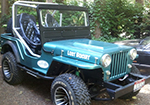UPDATE: Kudos to Greg Zyla for updating his column with the history corrections I suggested. You can read about it here: http://www.hamburgreporter.com/article/20121105/NEWS/121109944/-1/sports
(Published 10/30/2012)
I ran across this article about Jeep History: http://www.enterprisenews.com/lifestyle/columnists/x255960865/Greg-Zyla-Jeep-American-Bantam-and-Willys-Overland
If you read the article, you will see there are a few of the usual historical errors. I wrote a letter to the author with some thoughts on corrections. I’ve included them below to help those that aren’t as familiar with jeep history. I’ve also included them just in case I got something wrong.
1. The first jeep sold by Willys-Overland in 1945 to the public was the Willys CJ-2A. Very Early CJ-2A production units used some left over parts from the military versions, making VEC CJ-2As highly collectible among civilian jeep collectors.
2. The Willys Quad was the first prototype Willys-Overland developed in 1940 (the second Prototype was the Willys MA).
3. The Willys Quad wasn’t exactly a ‘copy’ of the Bantam BRC, although there were similarities, partly because Willys got to look at the Bantam plans before shipping the Quad.
4. Ford’s first Prototype was the Ford Pygmy. A second prototype was the Ford Budd (http://www.ewillys.com/2009/03/12/the-1940-buddy-a-ford-pygmybudd-prototype/ ). Their third prototype was the Ford GP (which doesn’t stand for General Purpose, but for G=Goverment and P=80″ Wheelbase). The WWII production jeep was the Ford GPW (the W standing for Willys Design).
5. Willys and Ford battled over the name Jeep. Willys didn’t win the right to use the name Jeep until the 1950s, which is the reason the hood and windshields of the CJ-2As and the CJ-3As were stamped Willys. There are a few rare CJ-2s that are stamped “JEEP” ( http://www.willys-overland.com/index.htm ).
6. While the original Bantam BRC is considered the first jeep, the jeep in the photo accompanying the article is a Bantam BRC-40 which was the third Prototype. (see the three different bantams here http://www.ewillys.com/2011/08/14/the-three-bantams-brc-brc-60-and-brc-40/ )
7. I am not aware that Bantam imported parts from England. I will have have to ask some friends about that.
8. Despite having arguably the worst of the three designs, Ford initially won the Army Quartermaster contract. However, there was enough push-back that the contract was transferred to Willys-Overland and Ford assigned as a second-source status.
NOTE: After reading this again, I probably should change the term prototype type to pilot for everything but the BRC, as the BRC was the real prototype/proof of concept, but that’s a little nit-picky for our purposes.

In reading throu some material last week, it was stated that one of the execs at bantem also was involved with willys, possibbly owned a willys dealership or more of the willys company. So there does appear that there was some “incest” there. Will see if I can find it.
History has a truth but sorting it out isn’t easy Here is another item I haven’t seen in other sources:
http://www.allpar.com/history/bantam-jeep.html
1940 was the time that the troubles for Bantam began. The Headquarters contingent that rejected everything began circulating disinformation about the ability of Bantam to engineer and produce the recon vehicle. It was being widely cast about that Bantam was too small to produce the quantity of vehicles that the Army would require. It was also said they did not have the engineering staff or the production people to get the machines and tools to set up for a high capacity production line, particularly in the case of making transfer cases and axles, the latter being true for the Butler facility. Ford had more production capability to make these than it had a place to put them.
In reality, though, Bantam had two production facilities; the first was in Detroit, and it built bodies that were shipped to Butler for attachment to a chassis. Combined, the two factories were well able to have produced over 200,000 (keep this figure in mind!) complete vehicles a year. This was backed up by an independent auditing contract that analyzed the two plants. Bantam just never had the sales to use the full capability of their facilities.
Roy Evans was the top salesmen who bought out the bankrupt american Bantam company. He hired the lobbiest to the govt. So did he really care who got the contract?
It should be noted at this point that Willys was not completely unrelated to Bantam. Even to this day, few people know that, in 1935, Evans had organized a syndicate to save Willys-Overland by purchasing 12,000 vehicles from Willys, which literally saved the company but gave controlling interest to Evans. Evans was one of the largest Willys dealers even as he ran Bantam. In 1938, former Chrysler salesman and executive (credited with naming Plymouth in 1928) Joseph Frazer became president of Willys, and ordered improvements to the twelve-year-old 4 cylinder Whippet engine. That would be important to Bantam’s entry.